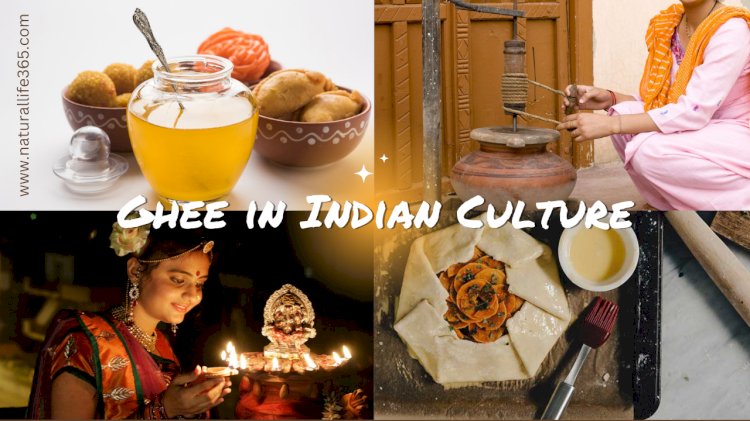Why is Ghee Important in Indian Culture?
Ghee, a type of clarified butter, plays a significant role in Hinduism. This blog post explores the cultural, religious, and nutritional importance of ghee in Hinduism, and how it is used in various rituals and ceremonies.

After the blog about Ghee vs. Butter: Which is Healthier? Here, you have a new blog about its importance in the Indian culture:
- Brief Overview of Ghee and Its Cultural Significance in India
- Historical Significance of Ghee in India
- How Ghee is Used in Various Hindu Rituals and Ceremonies?
- Nutritional Value of Ghee
- Ghee in Modern India
- Final Thoughts
Brief Overview of Ghee and Its Cultural Significance in India
Ghee is a type of clarified butter that has been used in Indian culture for centuries. It is an integral part of Indian cuisine, religion, and traditional medicine. Ghee is made by simmering butter and removing the milk solids, resulting in a pure and golden liquid that has a nutty and rich flavor.
Ghee has gained popularity in recent years as a health food, but it holds a deep cultural significance in Indian society that goes far beyond its nutritional value. In this article, we will explore why ghee is important in Indian culture, and its historical significance, nutritional value, cultural significance in daily life, and its role in modern India.
This clarified butter has been an essential part of Indian culture since ancient times, and it continues to hold a special place in Indian society today. It is a versatile ingredient used in many traditional Indian dishes, such as curries, sweets, and bread. Ghee is also an important part of religious ceremonies and rituals, and it is used in traditional Ayurvedic medicine and beauty treatments.
In the following sections, we will explore the rich history of ghee in India, its nutritional value, its cultural significance in daily life, and its role in modern India. Whether you are a ghee enthusiast or simply interested in learning more about Indian culture, this article will provide you with a comprehensive understanding of why ghee is such an important and beloved part of Indian society.
Historical Significance of Ghee in India
Ghee has a long and rich history in India, dating back thousands of years. In ancient Ayurvedic texts, ghee is described as a sacred and medicinal substance with numerous health benefits. Ayurvedic practitioners have long used ghee in their traditional healing practices, and it is believed to have a balancing effect on the body's doshas, or energy systems.
Ghee also has a significant role in Hinduism, where it is regarded as a symbol of purity and auspiciousness. It is used in many religious ceremonies and rituals, such as lighting lamps during Diwali, the festival of lights. In some parts of India, ghee is even used as a substitute for oil in temple lamps, as it is believed to purify the air and create a more holy atmosphere.
In Indian cuisine, ghee is used in many regional variations and is considered an essential ingredient in many traditional dishes. In North India, ghee is often used to make savory dishes, such as dal and biryani, while in South India, it is commonly used in sweet dishes, such as payasam and halwa. Ghee is also used to add richness and depth of flavor to many types of bread, including naan, paratha, and roti.
In addition to its culinary and religious significance, ghee has also played an important role in Indian society as a symbol of wealth and status. In ancient times, cows were considered a valuable asset, and ghee was a way to showcase one's wealth and social standing. Today, ghee is still seen as a luxurious and indulgent food, and it is often used to celebrate special occasions, such as weddings and festivals.
In this way, ghee has a rich and varied history in India, encompassing its use in traditional medicine, religion, cuisine, and social status. Its long-standing cultural significance is a testament to the important role that ghee has played in shaping Indian society and culture.
How Ghee is Used in Various Hindu Rituals and Ceremonies?
As mentioned before, ghee has been an important part of Hindu culture for centuries and is used in various rituals and ceremonies. It is believed to have purifying properties and is often used as an offering to the gods and goddesses.
One of the most significant uses of ghee in Hindu rituals is in the yajna, a fire ceremony that is performed for various purposes, such as for peace, prosperity, or the fulfillment of a wish. Ghee is poured into the fire during the ceremony, symbolizing the offering of one's ego or individuality to the divine.
Ghee is also used in the aarti, a ritual of worship that involves offering light to the deity. A lamp made of cotton wicks soaked in ghee is lit and offered to the deity, signifying the removal of darkness and the bringing of light and positivity.
In some Hindu rituals, ghee is also used for abhishekam, a ceremony where a deity is bathed with various liquids, including milk, honey, and ghee. It is believed that the offerings purify and energize the deity, creating a positive aura and environment.
Ghee is also used in the preparation of prasad, the food offering given to the deity and distributed among devotees. Many Prasad recipes call for ghee as it is believed to add a divine and auspicious quality to the food.
In addition to these rituals, ghee is also used in various personal and household ceremonies. For example, it is used during the mundan, the ceremony where a child's head is shaved for the first time. Ghee is applied to the scalp after the head is shaved, signifying the purification and initiation of the child into a new phase of life.
Overall, ghee's use in Hindu rituals and ceremonies is a reflection of its cultural and spiritual significance in India. Its purifying properties and auspicious qualities have made it an essential ingredient in various offerings and rituals, adding a sense of devotion and positivity to these practices.
Nutritional Value of Ghee
Ghee is often touted for its nutritional value and health benefits. Although it is high in saturated fat, ghee contains several essential vitamins and minerals that make it a healthy addition to your diet in moderation.
One of the key nutritional benefits of ghee is that it is rich in conjugated linoleic acid (CLA), a type of omega-6 fatty acid that has been shown to have anti-inflammatory and anti-cancer properties. CLA has also been linked to improved insulin sensitivity, reduced body fat, and increased muscle growth, making ghee a popular choice for athletes and fitness enthusiasts.
Ghee is also a good source of fat-soluble vitamins, including vitamins A, D, E, and K. Vitamin A is essential for maintaining healthy vision, skin, and immune function, while vitamin D is important for strong bones and teeth. Vitamin E is a powerful antioxidant that can help protect against free radical damage, while vitamin K is necessary for blood clotting and bone health.
In addition to its vitamin content, ghee is also rich in short-chain and medium-chain fatty acids, which are easily digestible and provide a quick source of energy for the body. These fatty acids have also been linked to improved cognitive function and lower risk of heart disease.
It is important to note, however, that ghee is high in calories and should be consumed in moderation as part of a balanced diet. One tablespoon of ghee contains approximately 112 calories, 12.7 grams of fat, and 7.9 grams of saturated fat.
Ghee in Modern India
Ghee has been a staple in Indian cuisine and culture for centuries, and it continues to hold significant cultural and nutritional value in modern India. In recent years, ghee has experienced a resurgence in popularity, both in India and around the world.
One of the reasons for the renewed interest in ghee is its perceived health benefits. Ghee is a rich source of healthy fats, vitamins, and antioxidants. It is also lactose-free and contains no casein, making it a suitable option for those who are lactose intolerant or sensitive to dairy products. Ghee is believed to improve digestion, boost immunity, and promote overall health and well-being.
In modern India, ghee is widely available in grocery and online stores, and many people continue to use it in their daily cooking. However, the traditional method of preparing ghee at home is still prevalent in many households, with some families taking pride in producing their own ghee using traditional techniques.
Ghee has also found a place in the Indian wellness industry, with many Ayurvedic practitioners promoting its use in various forms, such as ghee massages and herbal ghee preparations.
In addition to its health benefits, ghee continues to play a significant role in Indian culture and traditions. It is still used in religious ceremonies and rituals, and it remains a popular gift during weddings and other special occasions. As mentioned before, ghee is also used in many Indian sweets and desserts, giving them a rich, buttery flavor.
Overall, ghee's cultural and nutritional significance has ensured its continued relevance in modern India. Its popularity in the wellness industry, as well as its versatile use in cooking, has led to its increasing global popularity. As such, ghee is not only a cultural symbol but also a modern superfood with a range of benefits for health and wellness.
Final Thoughts
Ghee has been an integral part of Indian culture and cuisine for centuries, and its significance continues to this day. From its historical significance to its nutritional benefits, ghee has played a crucial role in shaping Indian traditions and lifestyles.
As we've explored, ghee is a healthy and flavorful option for cooking and wellness. Its lactose-free and casein-free properties make it a great alternative to butter and other dairy products for people with lactose intolerance or sensitivity.
Beyond its nutritional value, ghee also holds cultural significance in India. It has been used in religious ceremonies and rituals, and it remains a popular gift during special occasions. Ghee is also a key ingredient in many Indian sweets and desserts, adding a rich, buttery flavor that is loved by many.
Overall, ghee remains an important part of Indian culture and cuisine, and its versatility, nutritional value, and cultural significance ensure that it will continue to be a beloved and cherished ingredient for years to come.
If you value these free online resources provided by Natural Life 365, please consider supporting my website by sharing the blogs![]()









































